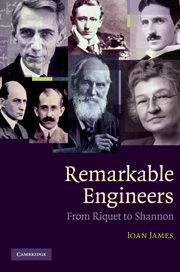Book contents
- Frontmatter
- Contents
- Preface
- Prologue
- 1 From Riquet to Watt
- 2 From Jessop to Marc Isambard Brunel
- 3 From Trevithick to Sadi Carnot
- 4 From Henry to Bazalgette
- 5 From Eads to Bell
- 6 From Braun to Hertz
- 7 From Diesel to Marconi
- 8 From Pal'chinskii to Zworykin
- 9 From Gabor to Shannon
- Epilogue
- Bibliography
- Credits
- Image credits
2 - From Jessop to Marc Isambard Brunel
Published online by Cambridge University Press: 17 December 2010
- Frontmatter
- Contents
- Preface
- Prologue
- 1 From Riquet to Watt
- 2 From Jessop to Marc Isambard Brunel
- 3 From Trevithick to Sadi Carnot
- 4 From Henry to Bazalgette
- 5 From Eads to Bell
- 6 From Braun to Hertz
- 7 From Diesel to Marconi
- 8 From Pal'chinskii to Zworykin
- 9 From Gabor to Shannon
- Epilogue
- Bibliography
- Credits
- Image credits
Summary
WILLIAM JESSOP (1745–1814)
Among Smeaton's apprentices was a young man who became first his assistant, then his partner. William Jessop has been unfairly neglected; because not very much is known about his life, apart from his work. His parents, Josias and Elizabeth Jessop, had three other children: two younger sons and one daughter. William, the future engineer, was born on 23 January 1745 at Devonport, where his father was employed. When Smeaton arrived in Plymouth in 1756 to build the new Eddystone lighthouse, he placed Josias in charge of the workyard and they worked together until it was finished three years later. It was hardly surprising when Josias' son William, who was keen to be trained in engineering, was accepted by Smeaton as an apprentice and thus William learned the basics of theoretical and practical engineering at Austhorpe Lodge.
At the age of 27, Jessop was beginning to act as Smeaton's junior partner. His first major work was in Ireland, where he extricated the government from difficulties over the construction of the Grand Canal that links the Liffey at Dublin with the Shannon near Banagher. Under his capable aegis, the line westwards was resurveyed, the fine Leinster aqueduct was built over the Liffey at Sallins, and the canal was driven successfully across the Bog of Allen. In 1773, still under 30, he was elected a member of the Smeatonian society.
- Type
- Chapter
- Information
- Remarkable EngineersFrom Riquet to Shannon, pp. 16 - 32Publisher: Cambridge University PressPrint publication year: 2010



